I. Introduction
In the first part of Schubert's C-Major Moment Musical, the return of the opening theme has all the drama of a recapitulation after a long and episodic development. The preceding "development," however, is very short, and does not prepare in any customary way for the return of the theme. After touching on A minor and G major, this central, developmental passage (Ex. 1, mm. 9-18) shifts suddenly to E minor, then breaks down its triple meter first into duple groups and then into isolated single beats as it urgently climaxes on E minor's dominant. Gesturally, the G-E note-pairs that follow merely echo this climax, as if to open a clearing for a fuller E-minor music to follow.
Example 1.
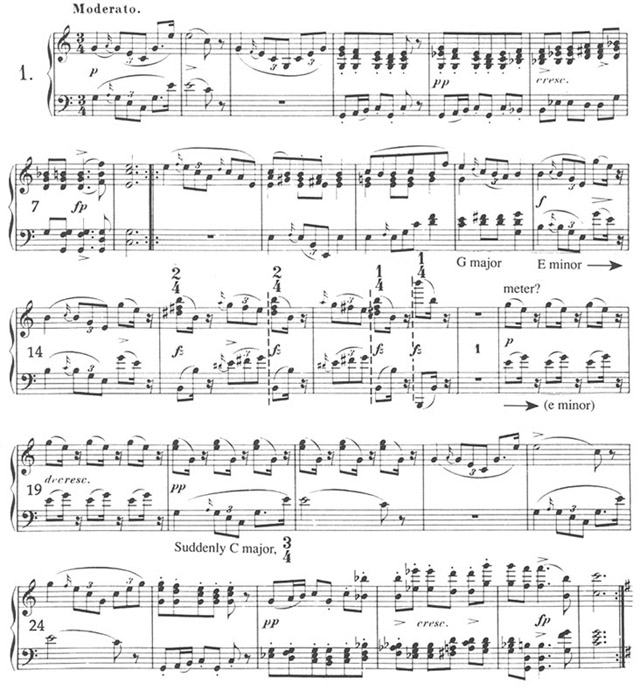
No accentuation re-establishes the triple meter; instead the note-pairs resound like isolated cuckoo-calls. When the theme returns beneath these calls, it immediately restores its C-major tonality and its triple meter to the music as if by magic. It creates the illusion of music born or reborn of natural sounds. One can aptly call this theme's return, in its recovery of music from an image of nature, a "moment musical," a special moment of transformation, in this case a moment in which music itself is created anew.
Moments of sudden, in some ways disjunctive tonal and textural change, at times like catharses or wished-for catharses, at others like fallings from grace, occur frequently in Schubert's music, and especially so in the Moments Musicaux. Even Schubert's special way of handling the frequent shifts from minor to major qualifies them as such moments. Of course this Schubertian device has many precedents in tonal music, Picardy thirds and Maggiore variations among the simplest of them. But Schubert's changes to major sound more often like inner transformations than like mere changes of mood: instead of introducing new material in the major mode into a context of the minor, Schubert typically transforms the same or almost the same gestures that were minor into major, as if the minor-mode music wanted to be major all along and is finally allowed to be. Both F-minor Moments Musicaux, Nos. 3 and 5, end this way, as does the  -minor contrasting material of No.2. One can also understand the endings of both the
-minor contrasting material of No.2. One can also understand the endings of both the  -minor and
-minor and  -major Moments Musicaux, Nos. 4 and 6, in relation to the same device. Instead of transforming its principal material into major, the
-major Moments Musicaux, Nos. 4 and 6, in relation to the same device. Instead of transforming its principal material into major, the  -minor Moment Musical recalls the parallel-major music of its middle section just before it ends, leaving major and minor in ambiguous equilibrium. The ending of the last Moment Musical turns suddenly minor, as if it cannot hold on the hope that the major mode embodies (Ex. 2a).
-minor Moment Musical recalls the parallel-major music of its middle section just before it ends, leaving major and minor in ambiguous equilibrium. The ending of the last Moment Musical turns suddenly minor, as if it cannot hold on the hope that the major mode embodies (Ex. 2a).
Example 2a.
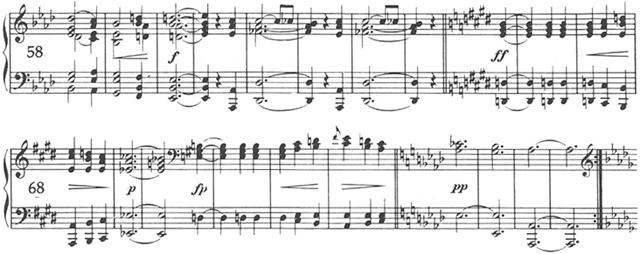
Sudden as it seems, this moment of darkening, this negative transformation arises from earlier events in the piece. Edward T. Cone traces it back to the undermining influence of the  (or
(or  ) in measure 12 (Ex. 2b).1
) in measure 12 (Ex. 2b).1
Example 2b.
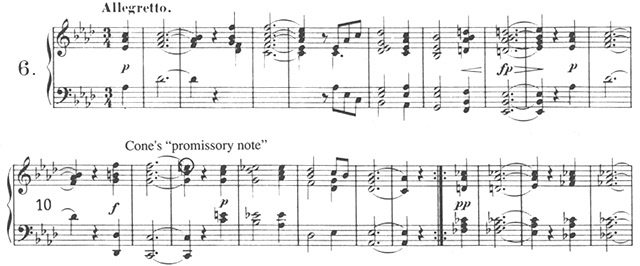
This promissory note," as Cone calls it, engenders another kind of "moment musical" in the middle of the piece, one involving a sudden, unexpected shift of tonal center. The period after the double bar begins in  minor, already establishing a precedent for the minor ending (Ex. 2c).
minor, already establishing a precedent for the minor ending (Ex. 2c).
Example 2c.
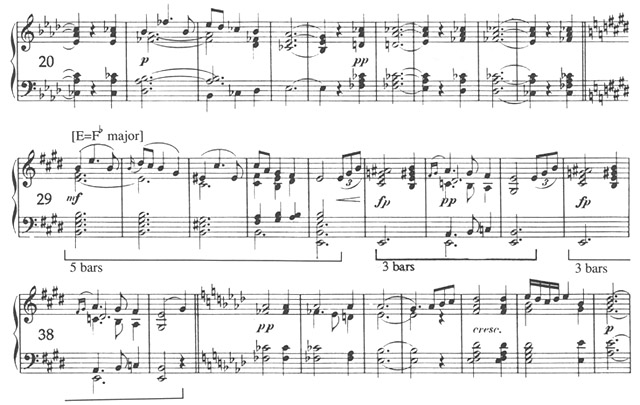
But instead of cadencing here in this key, the last part of this period (mm. 29ff.) suddenly shifts to  major (notated as E). This only partly prepared appearance of
major (notated as E). This only partly prepared appearance of  major is heard as a special moment, and the irregular subphrases that follow in this key (of 5, 3 and 3 measures respectively) have the effect of prolonging that moment, of hanging on it by suspending the normative temporal progression of the music in two- and four-bar units. In such unprepared shifts as this to remote-sounding tonal regions, a lack of harmonic transition, discontinuity of texture or (as here) of phrase-rhythm keeps the remote tonality sounding remote, as if imagined rather than achieved. Like these phrases in the last Moment Musical, the
major is heard as a special moment, and the irregular subphrases that follow in this key (of 5, 3 and 3 measures respectively) have the effect of prolonging that moment, of hanging on it by suspending the normative temporal progression of the music in two- and four-bar units. In such unprepared shifts as this to remote-sounding tonal regions, a lack of harmonic transition, discontinuity of texture or (as here) of phrase-rhythm keeps the remote tonality sounding remote, as if imagined rather than achieved. Like these phrases in the last Moment Musical, the  -major phrase (Ex. 6, mm. 42-44) at the middle of the second A section of the second Moment Musical sounds imaginary in this way.
-major phrase (Ex. 6, mm. 42-44) at the middle of the second A section of the second Moment Musical sounds imaginary in this way.
Thus one might take the term "moment musical" to characterize several types of special, transformative or conflictual moments in Schubert's music, moments that figure prominently in every one of the pieces bearing this title. Admittedly, it is unlikely that Schubert intended the title to refer specifically to such moments.2 Like "Impromptu," "Moment Musical" conveys a general sense of the improvisatory, the unpremeditated in contrast to deliberate, functionally articulated composition in sonata forms. Many still think that Schubert felt especially at home in these pieces because they resemble songs more closely than sonatas, and so suit his predominantly lyrical temperament. But the discontinuities, the sudden radical changes, the "moments musicaux" in the sense I have indicated, are as characteristic of Schubert as his songfulness. Because of these moments, the title "Songs without Words" would characterize these pieces far less adequately. This is not to deny that Schubert's songs, too, abound with such moments. One of his most significant innovations, arguably, is the integration of such "moments musicaux" into song, as one way of embodying in music the developing actions and changing mental states in the poems he set.
The "moments musicaux" I have described are disjunctive, unexpected, usually disruptive of some established aspect of musical continuity even when they play an integrative role. But the first two pieces in the set bearing this title seem to question the nature of this continuity itself. Each of these pieces, in its own way, resists to an unusual degree the hierarchization of moments that ordinarily produces a sense of direction in tonal music. The first exhibits what Carl Schachter calls a "wayward, unpredictable character";3 in the words of John Rothgeb, it proceeds by combining "an advancement of content with reference to a past event."4 Until the return of its opening motto, each subphrase of the A section begins by echoing, by rehearing some part or aspect of the preceding subphrase. The retention or reverberation of one moment, a reluctance to let it pass, provides the impetus for the next. The second piece, primarily through its sustained chords and metrical ambiguities, secondarily through its avoidance much of the time of strong harmonic and melodic movement, produces a sense of hovering, of questioning without finding answers. To a much greater degree than most tonal music, it equalizes its musical events. One hears primarily a succession of moments, each of them poignantly individualized; only subordinately does one hear the way these moments combine to produce complete phrases and cadential resolutions. In spite of the tenuous continuity of the openings of these two pieces, they still exhibit enough continuity to provide contexts for such "moments musicaux" as I have described above, and for such moments to participate, ultimately, in the achievement of fuller continuity.
In what follows, I shall develop and substantiate these claims about the first two Moments Musicaux. Since several reliable and detailed analyses of the first have appeared in print, my comments on this piece will necessarily refer to and elaborate on points made in these analyses.5 The one published analysis I know of the second, by Patrick McCreless, differs so markedly from mine in emphasis that I shall not refer to it in any detail in my own observations.6
In both these pieces, the contrasting, more song-like B sections throw into relief the special echoing-of-the-moment or hovering-in-the-moment of the A sections. But these two B sections nonetheless function very differently in their different contexts, and I shall conclude by contrasting the kinds of large-scale musical continuities that the two pieces generate.
II. Opus 94, No. 1 in C major
In the eight-measure phrase that opens this pastoral scene, the third and fourth measures already dwell in the reverberation of the first two, reducing their tension rather than building from them toward an anticipated goal. After the high, accented, calling third in measure 2, measure 3 begins again with the opening g1, but now alone, without its octave doubling. Remaining fundamentally within the tonic harmony, this second subphrase smooths out the rhythmic and melodic contours of the opening one: a second flowing triplet in measure 3 replaces the angular dotted rhythm at the end of measure 1; a repetition of g1 at measure 4 replaces the striking leap up to e2 of measure 2; and a falling figure in eighth notes, filling in a third, takes the place of the tense, agogically stressed half-note of the opening motto. The third subphrase begins, then, not merely as an echo, but in a sense as the echo of an echo. Until the end of measure 5, the music continues to reverberate, losing tension. Only the hemiolas of the next two measures, along with their mercurial harmonic changes, recover the energy of the opening gesture. But because they arise from the pianissimo parallel minor, these harmonies sound obscure, as if they come from offstage: they do little to destroy the sense of wonderment that the entire first phrase generates by unfolding so fully within the reverberating arpeggiation of its tonic triad.
Beginning with a lonely echo of the first phrase's melodic cadential e2, the phrase after the double bar (mm. 9-12) emerges even more tentatively, ambiguously, its goal unclear right up to its G-major cadence. The harmonies of measures 10 and 11 are in fact ambiguous enough that Carl Schachter and John Rothgeb disagree over the proper identification of the chords themselves.7 Rothgeb hears an E-major triad, V of A minor, supporting a melodic b1 in measure 10, echoed as an E-minor triad when the same melody recurs in measure 11, and thus paralleling the way measure 5 creates a minor-mode echo of measure 4. Schachter hears the entire passage as prolonging further the tonic triad of the opening phrase, so that the melodic b1 threatens but remains subordinate to the c1 that it neighbors, and so that the  1 of the E-major chord in measure 10 becomes in retrospect a chromatic passing tone between a1, an upper neighbor, and g1, its tone of resolution. Of course the prolongation of a C-major or any other triad does not preclude the emergence through voice-leading of E-major or E-minor triads—or of virtually any other common chords, for that matter—in the foreground of that prolongation. Schachter's interpretation of the chord in measure 11 depends as fundamentally on the voice-leading of that measure as on the measures that surround it. Nevertheless, though Schachter's analysis makes good sense, I cannot bring myself to hear a C-major chord as controlling measure 11 while this measure sounds. I am persuaded to hear first what Rothgeb hears and only then, in memory, to hear what Schachter hears. And I am tempted to reconcile their analyses by claiming that Schubert has written this passage in such a way that each progression, each moment of the music, becomes not only past but illusory—not what it seemed to be—the moment it has passed. Thus measure 10 registers clearly as a semicadence in A minor; but its echo in measure 11, where a repeated g1 replaces the inner-voice progression a1-
1 of the E-major chord in measure 10 becomes in retrospect a chromatic passing tone between a1, an upper neighbor, and g1, its tone of resolution. Of course the prolongation of a C-major or any other triad does not preclude the emergence through voice-leading of E-major or E-minor triads—or of virtually any other common chords, for that matter—in the foreground of that prolongation. Schachter's interpretation of the chord in measure 11 depends as fundamentally on the voice-leading of that measure as on the measures that surround it. Nevertheless, though Schachter's analysis makes good sense, I cannot bring myself to hear a C-major chord as controlling measure 11 while this measure sounds. I am persuaded to hear first what Rothgeb hears and only then, in memory, to hear what Schachter hears. And I am tempted to reconcile their analyses by claiming that Schubert has written this passage in such a way that each progression, each moment of the music, becomes not only past but illusory—not what it seemed to be—the moment it has passed. Thus measure 10 registers clearly as a semicadence in A minor; but its echo in measure 11, where a repeated g1 replaces the inner-voice progression a1- 1, makes that semicadence and its tonality seem illusory in retrospect, because in that echo one is hearing the same musical shape again, but in rehearing it, hearing it as something different. By measure 12, the E-minor triad, too, seems to have been illusory, absorbed into the C-major chord from which the phrase now progresses to a fleeting cadence in G major.
1, makes that semicadence and its tonality seem illusory in retrospect, because in that echo one is hearing the same musical shape again, but in rehearing it, hearing it as something different. By measure 12, the E-minor triad, too, seems to have been illusory, absorbed into the C-major chord from which the phrase now progresses to a fleeting cadence in G major.
In Rothgeb's and Schachter's readings, this phrase parallels the opening phrase in different ways. As already indicated, Rothgeb draws a parallel between the echo at the midpoint of the opening phrase (mm. 4-5) and the one at the midpoint (mm. 10-11) of the four-measure phrase after the double bar. But Schachter's reading reveals a deeper parallelism: the second phrase, like the first, simply dwells, for all the appearance of harmonic movement on its surface, within its tonic triad, only departing from it at the last possible moment (m. 12). If these readings could be taken together, their observations would combine to make of the second phrase a kind of microcosm, a large-scale echo, of the first.
Even as the second phrase finally makes a definite move away from the tonic-triad territory of the first, it continues to reverberate with what has already been heard: from the end of measure 11 through measure 12, its melody echoes (as Rothgeb points out) that of measures 7-10, which joined the first two phrases. At the same time, this second phrase has set up an internal echo from measure to measure, the bass of measure 10 resounding from the melody of measure 9, the bass of measure 11 repeating while subtly disintegrating the same melodic contour, and thus maintaining an impetus for the return of triplets into the cadential melody of measure 12.
If the E-minor triad of measure 11 already seemed illusory by measure 12, then the following phrase seizes and becomes fixated upon that "illusory" sonority, negating in turn any sense of even momentary repose gained in the G-major cadence. Schachter perceptively identifies the gesture of measure 13 as a compression of the piece's opening gesture. But just before it arrives, the beginning of this new phrase has also been pre-echoed by the two preceding measures: the melody drives home the b1 just established. The harmony, as I have already indicated, forcefully recalls the evanescent E minor; and the rhythm combines that of measure 12 with the end of measure 11. In measure 14, for the first time, comes blatant repetition—the negation of echoing—and then further compression, again through hemiola in measures 15-16, and culminating, as Lawrence Moss observes, in one-beat subphrases at the end of measure 16.8 Even after the silence of the next measure, one hears the ensuing ostinato of g1-e1 duplets as prolonging an E-minor harmony while gesturally echoing the violent climax of measure 16. But that harmony, even in this violence, remains an illusion: it will disappear before any further E-minor progression confirms it. At the same time, the rhythmic compression of the phrase just heard, obscuring the triple meter beneath groups of two beats and then even of one, makes the new ostinato rhythmically ambiguous. Nothing in measures 17-19 indicates clearly whether one should hear it in groups of one, two or three beats. Its metrical context dismantled in the preceding climax, this ostinato seems to recover to this music the natural sounds—I have characterized them as cuckoo calls—that it imitates.
Beneath these "natural sounds," the opening motto returns as an epiphany, without harmonic preparation, in the "moment musical" I have already described in the introduction. In fact, the music has never decisively confirmed my tonal motion away from C major; more than in most modulatory passages, the tonic has remained latently present all the time, and simply re-emerges here. The memory of the climactic Bs, still reverberating beneath the calling ostinato, fades into the C of the opening's recall. Through imitative counterpoint, the opening material wells up rather than beginning to echo away, and thus confirms the reality of the epiphany as the music finds its way to "be" an assurance of its own continuity. The melody of the second subphrase sounds this time an octave higher than before (cf. mm. 24-25 with mm. 3-4), its high g2 thus becoming a melodic goal. Schubert's recourse to contrapuntal inversion here also subverts the echoing effect through which the final subphrase emerged before (cf. m. 26 with m. 5), so that this passage now carries forward the new impetus established in measure 25.
In the B section of the piece, as Schachter writes, "the rhythms are repetitive and symmetrical in contrast to the fluid prose rhythms of the A part; the character is more given, more real than that of the searching, mysterious opening section."9 But also central to my conception of the piece is a contrast that I would like to characterize more fully than Moss, Schachter or Rothgeb chose to do in their analyses: the music of the B section progresses in a normative melodic and harmonic way from one phrase to the next. Thus its first phrase ends (Ex. 3, m: 33) with a semicadence, to which its second phrase responds with an imperfect authentic cadence in the same key; the first features a prominent melodic motion from g1 up to c2, which the second carries forward from d2 up to g2.
Example 3.
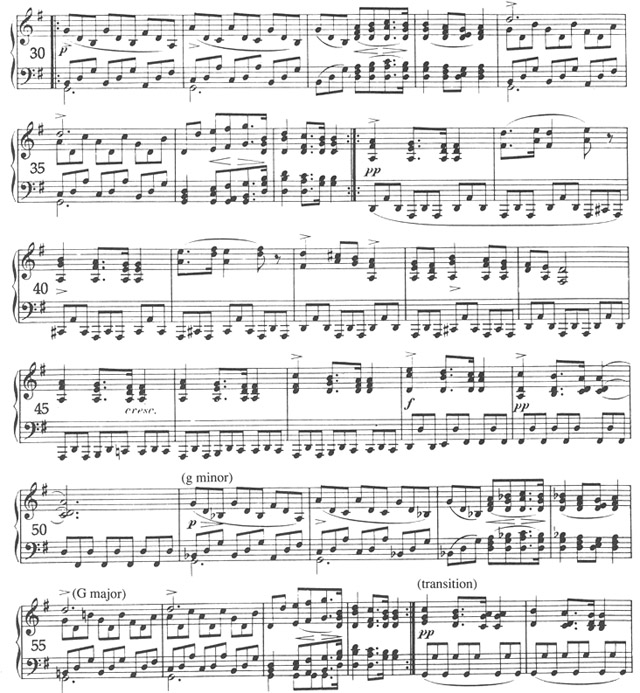
The music after the double bar exhibits similarly directed motion, rising consistently through measures 38-42, and then falling naturally. The playful use of hemiola as this phrase falls away from its climax (mm. 42-44) both recalls the uses of this rhythmic device in the A section, and highlights again the contrast between it and the B section. There, hemiola recovered the energy of the music from the lull of reverberation; here, it gently hastens the relaxing fall of a phrase.
At the return of this B section's main idea (m. 51), the point corresponding to the return of the opening in the A section, a kind of negative "moment musical" occurs: G minor replaces G major for the antecedent phrase, as if to question the memory of that return along with the self-assurance achieved in this B section. This minor phrase enables the consequent to follow as another epiphanic moment, once again in the major mode, dispelling the momentary doubt.
III. Opus 94 No. 2 in  major
major
The opening of this piece (Ex. 4) owes its hovering quality partly to its melody, which in its first four measures rocks gently from c1 to its upper neighbor, then to its lower neighbor, then a step higher than before, then back to c1.
Example 4.
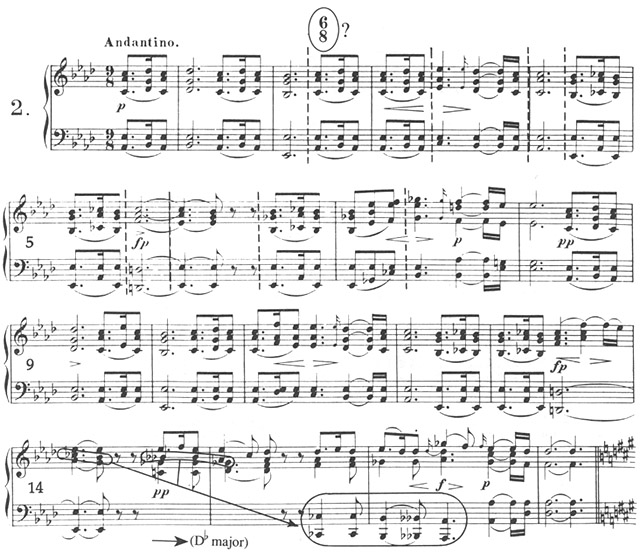
Except in the second measure, the bass simply shadows the melody, rocking with it. The second phrase brings  , the second scale-degree, into focus, but a long-held neighboring
, the second scale-degree, into focus, but a long-held neighboring  distances this
distances this  from the C of the first phrase, and thus attenuates its tendency toward cadential resolution. The bass, now on the dominant, most importantly mirrors the melody's chromatic neighbor motion. Only then, in measure 7, does the melody suddenly take flight, rising in one quiet breath from
from the C of the first phrase, and thus attenuates its tendency toward cadential resolution. The bass, now on the dominant, most importantly mirrors the melody's chromatic neighbor motion. Only then, in measure 7, does the melody suddenly take flight, rising in one quiet breath from  1 up to an ephemeral
1 up to an ephemeral  2, and then falling back to its first harmonically supported cadence, on
2, and then falling back to its first harmonically supported cadence, on  2. Only in this last subphrase does the bass, too, become more active. But even now, the force of the cadence is attenuated: it moves toward
2. Only in this last subphrase does the bass, too, become more active. But even now, the force of the cadence is attenuated: it moves toward  minor rather than
minor rather than  major, as if to negate the piece's
major, as if to negate the piece's  -major ambience, and the phrase comes back to the
-major ambience, and the phrase comes back to the  -major world only when its last chord restores g natural.
-major world only when its last chord restores g natural.
Just as noteworthy as the melodic and harmonic subtlety of this opening is its metrical ambiguity.10 In the first two measures, a listener might at first correctly identify the downbeats with the long notes, notated as dotted half-notes. But when the third measure exactly reiterates its own upbeat as its downbeat, and follows this accent-concealing repetition with a leap up to  1 on its second beat, the listener will probably hear the initiating upbeat as the downbeat of a 6/8 measure, followed by another 6/8 measure beginning on the
1 on its second beat, the listener will probably hear the initiating upbeat as the downbeat of a 6/8 measure, followed by another 6/8 measure beginning on the  2.11 Retrospectively, this listener will experience confusion (even if in the form of poignant questioning) about the metrical placement of the opening gestures as well. This metrical ambiguity will persist throughout the entire A section, with respect to both the placement of metric accents and the length of measures, which seem sometimes to be 6/8, sometimes the notated 9/8. (I do not wish to imply that a performer should "rebar" this music internally; I find it most subtle and interesting when inwardly imagined as written;12 but much of that subtlety arises from the ambiguities I describe here, which I suspect few listeners could resolve without the help of a score.)
2.11 Retrospectively, this listener will experience confusion (even if in the form of poignant questioning) about the metrical placement of the opening gestures as well. This metrical ambiguity will persist throughout the entire A section, with respect to both the placement of metric accents and the length of measures, which seem sometimes to be 6/8, sometimes the notated 9/8. (I do not wish to imply that a performer should "rebar" this music internally; I find it most subtle and interesting when inwardly imagined as written;12 but much of that subtlety arises from the ambiguities I describe here, which I suspect few listeners could resolve without the help of a score.)
The second phrase-group takes an especially unexpected turn. Its first six measures repeat those of the first group, with subtle melodic variations. But then, in a sudden moment of harmonic redirection and metrical clarification, a single measure-long subphrase tonicizes  major (m.15).13 Although no harmonic event before measure 15 prefigures this arrival in the subdominant, the immediately following cadence confirms this unorthodox tonal goal, repeating as its initiating bass-line a chromatic descent from
major (m.15).13 Although no harmonic event before measure 15 prefigures this arrival in the subdominant, the immediately following cadence confirms this unorthodox tonal goal, repeating as its initiating bass-line a chromatic descent from  to
to  that, as an inner-voice motion in measures 13-15, linked the two preceding subphrases. The music seems suddenly to happen upon this tonal region, to be drawn there rather than actively to go there.
that, as an inner-voice motion in measures 13-15, linked the two preceding subphrases. The music seems suddenly to happen upon this tonal region, to be drawn there rather than actively to go there.
In a sense, the  minor of the music that follows (Ex. 5) "explains" this
minor of the music that follows (Ex. 5) "explains" this  , for
, for  major functions in retrospect as the dominant of
major functions in retrospect as the dominant of  (=
(= ) minor and so prepares its arrival.
) minor and so prepares its arrival.
Example 5.
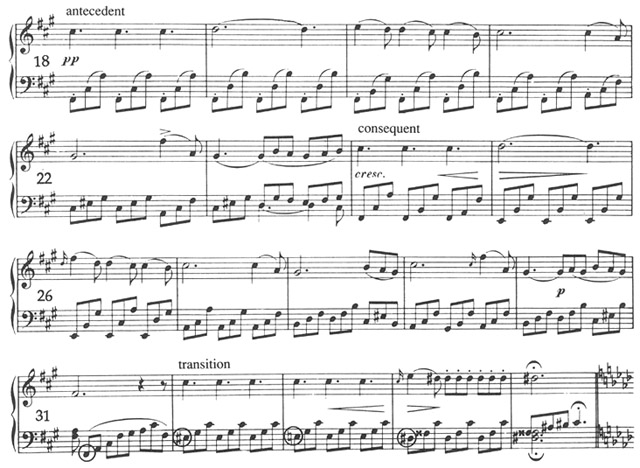
But  minor, with its nine flats, could hardly be more remote from the
minor, with its nine flats, could hardly be more remote from the  major of the opening music, even if the melodic
major of the opening music, even if the melodic  of that opening's first cadence has intimated this strange key. This new music remains quietly within the same tempo. Moreover, its melody, though simpler, explores the same kind of neighbor motion—now around
of that opening's first cadence has intimated this strange key. This new music remains quietly within the same tempo. Moreover, its melody, though simpler, explores the same kind of neighbor motion—now around  (=
(= )—as the A section's melody. Indeed one can hear the entire section as generated through the upper neighbor,
)—as the A section's melody. Indeed one can hear the entire section as generated through the upper neighbor,  , of the A section's primary melodic tone, C, accompanied by the lower neighbor,
, of the A section's primary melodic tone, C, accompanied by the lower neighbor,  , of its fundamental bass,
, of its fundamental bass,  (Fig. 1).14
(Fig. 1).14
Figure 1.

But in spite of these continuities, the contrast between  major and
major and  minor underscores how markedly this new music contrasts with the preceding music in texture, metrical clarity, and harmonic and melodic direction. Instead of a five-part chorus, this new texture involves a lone voice quite far above an arpeggiated accompaniment. Altogether diatonic, with strongly defined motion to its cadences, it is a model of harmonic clarity. It also leaves no room for doubt about its triple, 9/8 meter or about the placement of its accented beats. Although its first phrase has six measures and its second, eight, these two phrases together clearly suggest a parallel period, the first phrase leading to a semicadence, the second responding to an unambiguous demand for a perfect authentic cadence. Unlike the A section, therefore, this part sounds self-contained, a simple song of unambiguous sadness.
minor underscores how markedly this new music contrasts with the preceding music in texture, metrical clarity, and harmonic and melodic direction. Instead of a five-part chorus, this new texture involves a lone voice quite far above an arpeggiated accompaniment. Altogether diatonic, with strongly defined motion to its cadences, it is a model of harmonic clarity. It also leaves no room for doubt about its triple, 9/8 meter or about the placement of its accented beats. Although its first phrase has six measures and its second, eight, these two phrases together clearly suggest a parallel period, the first phrase leading to a semicadence, the second responding to an unambiguous demand for a perfect authentic cadence. Unlike the A section, therefore, this part sounds self-contained, a simple song of unambiguous sadness.
The transition back to the A section retains the texture of the contrasting episode, but brings to that texture a kind of voice-leading foreign to it thus far. In its four measures, the bass descends chromatically from  to
to  (mm. 31-35, notated
(mm. 31-35, notated  to
to  ), in the same relation to
), in the same relation to  major as that of the chromatic bass-descent of the earlier
major as that of the chromatic bass-descent of the earlier  -major cadence (m.16) to that tonality. The second A section begins in fundamentally the same way as the first. But after six measures, where
-major cadence (m.16) to that tonality. The second A section begins in fundamentally the same way as the first. But after six measures, where  minor appeared before,
minor appeared before,  major now suddenly appears (Ex. 6, mm. 42-44), expanding on the resolute eighth-note rhythm first encountered in
major now suddenly appears (Ex. 6, mm. 42-44), expanding on the resolute eighth-note rhythm first encountered in  minor, later heard again in connection with the cadences of the B section (mm. 23 and 30).
minor, later heard again in connection with the cadences of the B section (mm. 23 and 30).
Example 6.
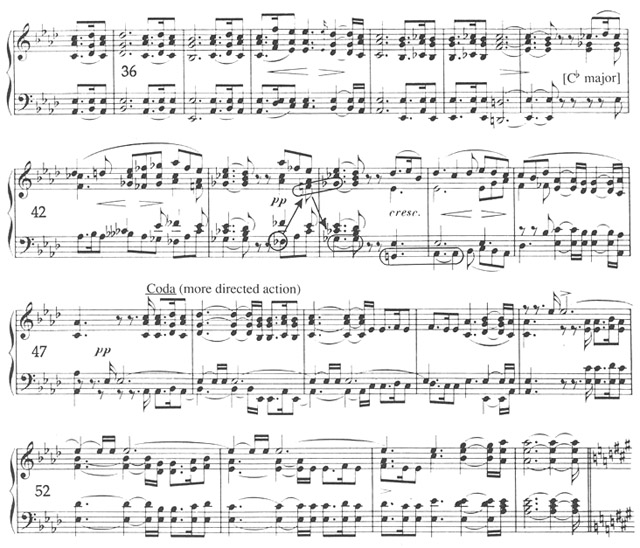
The  , which first appeared as the isolated melodic high point of the first cadence in the piece, now re-emerges as the supporting dominant bass. Measure 44 quietly echoes a
, which first appeared as the isolated melodic high point of the first cadence in the piece, now re-emerges as the supporting dominant bass. Measure 44 quietly echoes a  -major semicadence before this distant-sounding region vanishes behind the return of
-major semicadence before this distant-sounding region vanishes behind the return of  major, linked to it not only by the melodic common tone,
major, linked to it not only by the melodic common tone,  , but also by an implied chromatic ascent, mostly in the bass, connecting
, but also by an implied chromatic ascent, mostly in the bass, connecting  to
to  as it moves from
as it moves from  back up to this tonic pitch (see annotations in Ex. 6). The ensuing
back up to this tonic pitch (see annotations in Ex. 6). The ensuing  -major cadence leads into a coda, where reiterated off-beat
-major cadence leads into a coda, where reiterated off-beat  s help to clarify its now dancing meter, and where an initially sequential reinterpretation of the opening melody (mm. 48-49) initiates a clear descent to the tonic. Only here does the main theme begin to find within itself the definition and continuity it has sought.
s help to clarify its now dancing meter, and where an initially sequential reinterpretation of the opening melody (mm. 48-49) initiates a clear descent to the tonic. Only here does the main theme begin to find within itself the definition and continuity it has sought.
But this coda does not end the piece: fast upon it comes a second B section (Ex. 7), unexpectedly loud and impassioned, and so even more in contrast with the music of the A sections.
Example 7.
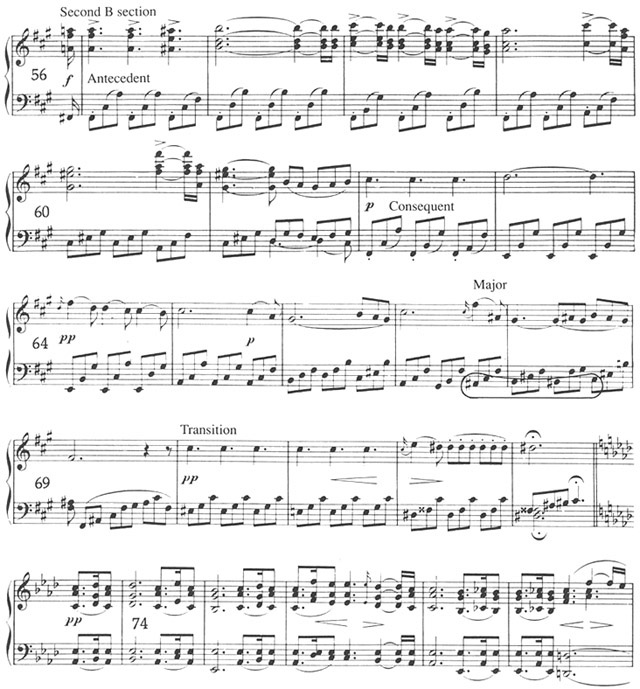
For its second phrase, this new B music calms to its original, quiet texture. Then comes the same cadential phrase as before, but unexpectedly in  (=
(= ) major, now accompanied by a chromatic bass-ascent from
) major, now accompanied by a chromatic bass-ascent from  up to
up to  (notated A-
(notated A- ), recalling and extending the chromatic melodic ascent with which this second B section surprisingly began. The major mode of this cadence signals another quiet "moment musical," not only transforming the mood of this ending, but bringing it tonally closer to the
), recalling and extending the chromatic melodic ascent with which this second B section surprisingly began. The major mode of this cadence signals another quiet "moment musical," not only transforming the mood of this ending, but bringing it tonally closer to the  major of the surrounding sections (in that
major of the surrounding sections (in that  major has six flats, closer to
major has six flats, closer to  major's four than was
major's four than was  minor's nine). The quiet surprise of this cadence dramatically counterbalances—or even negates—the jarring one encountered in the forte beginning of this second B section.
minor's nine). The quiet surprise of this cadence dramatically counterbalances—or even negates—the jarring one encountered in the forte beginning of this second B section.
The final A section is the simplest, for it undertakes no excursion comparable to the earlier ones to  minor and
minor and  major. It first proceeds similarly to the second phrase-group of the first A section, up through the one-measure subphrase tonicizing
major. It first proceeds similarly to the second phrase-group of the first A section, up through the one-measure subphrase tonicizing  major (cf. mm. 74-80 with 9-15). In what follows, however, the
major (cf. mm. 74-80 with 9-15). In what follows, however, the  -major triad now serves its true subdominant function, so that the same idea that originally brought a cadence in
-major triad now serves its true subdominant function, so that the same idea that originally brought a cadence in  major, transposed, now brings a cadence in
major, transposed, now brings a cadence in  major (cf. Ex. 8, mm. 81-82 with 16-17).
major (cf. Ex. 8, mm. 81-82 with 16-17).
Example 8.

The chromatic bass-descent into this cadential idea now occurs through the same pitches that underlie the passages linking the ends of the B sections with the returns of the A sections (cf. m. 81 with mm. 31-34 and 69-72) and thus signals the integration of those contrasting episodes into their present  major environment. The coda comes once again, but the stronger
major environment. The coda comes once again, but the stronger  -major cadence in measures 81-82 now confers on it a greater sense of finality than it had the first time.
-major cadence in measures 81-82 now confers on it a greater sense of finality than it had the first time.
IV. Overview of the two pieces
Comparison of these two pieces raises an obvious question: why does the material of the second Moment Musical require a five-part (ABABA) design, while a simple ternary (ABA) plan meets the demands of the first one's material? I have shown how the A sections of both, different as they are, both proceed hesitantly, the first finding ways to continue only by echoing or listening to itself, the second continually searching for clarification of emphasis and direction from moment to moment. The B sections of both pieces contrast markedly, both achieving in their greater simplicity a much clearer sense of tonal direction, a continuity more like that of simple song.
But in another way, the B sections of these two pieces stand in opposite relation to their respective A sections. (i) The A part of the first piece, itself a rounded binary design (a/ba), begins and continues tentatively, but concludes strongly in the return of its opening ideas: as Schachter has observed, this first part of the piece achieves full closure and can stand alone.15 The B section, also a clear rounded binary structure in the closely related dominant key of G major, reaffirms and carries forward the natural musical flow that the A section finally achieves: it retains but subordinates the triplet motive from the A section, now grounding the music in this motive as a textural element; and it incorporates the prominent upper-neighbor and ascending-fourth motives of the earlier music, subordinating them also to its directed motion. Thus the opening music finds its way to the kind of continuity that the trio or central episode then celebrates. (ii) The A section of the second Moment Musical not only begins tentatively; it ends tentatively, too, happening seemingly by accident upon a  -major cadence that leaves it open and incomplete. While connected through this
-major cadence that leaves it open and incomplete. While connected through this  -major harmony to the A section and related to it motivically, the music of the B section subverts rather than affirms what the A section has hesitantly established. Indeed the entire A section may seem at this point to have functioned merely as a preparation, an evanescent large-scale upbeat for the weightier, less ephemeral music of the B part. Even harmonically,
-major harmony to the A section and related to it motivically, the music of the B section subverts rather than affirms what the A section has hesitantly established. Indeed the entire A section may seem at this point to have functioned merely as a preparation, an evanescent large-scale upbeat for the weightier, less ephemeral music of the B part. Even harmonically,  major and
major and  major relate to
major relate to  minor as preparations, as V and V/V respectively:
minor as preparations, as V and V/V respectively:
A Section B Section
major
major
(=
) minor
V of V V i
Yet at the same time,  minor could hardly sound more distant from
minor could hardly sound more distant from  major, and its lonely melody suggests a voice unable to sound in the
major, and its lonely melody suggests a voice unable to sound in the  -major region or to take part in its choral texture. Like the "Wanderer" of Schubert's C Major Fantasy, Op. 15, the protagonist of this contrasting song also first emerges as a Fremdling, as an unassimilated inner voice. The experience of this contrasting episode seems incompatible with that of the opening music, and this experience has to occur again, more intensely, to break itself open in order to come into interaction with that other experience (of the A parts) within which it is embedded.
-major region or to take part in its choral texture. Like the "Wanderer" of Schubert's C Major Fantasy, Op. 15, the protagonist of this contrasting song also first emerges as a Fremdling, as an unassimilated inner voice. The experience of this contrasting episode seems incompatible with that of the opening music, and this experience has to occur again, more intensely, to break itself open in order to come into interaction with that other experience (of the A parts) within which it is embedded.
One metaphorical interpretation of this piece might make the B section into a disturbing memory. The music of the A section searches, perhaps for that memory, but does not yet succeed in recovering it. Though the memory sought remains at first unconscious, it is present from the beginning as a past that underlies the opening music. It has that music in its thrall, and influences or even causes its tonal digressions: thus  minor and
minor and  major lie between
major lie between  major and an already implicitly present
major and an already implicitly present  minor, and arise as disturbances of the
minor, and arise as disturbances of the  -major music because of the underlying psychic force of the still unintegrated memory that the
-major music because of the underlying psychic force of the still unintegrated memory that the  -minor region embodies. Indeed the melodic high point of the first cadence (mm. 7-8) is the
-minor region embodies. Indeed the melodic high point of the first cadence (mm. 7-8) is the  itself, later to become tonicized in the B section. Though that memory sounds clear and self-contained in its first recovery, it remains distant. Therefore this first remembrance of it does not fully dispel its psychic force, and accordingly the second A section still contains a tonal deflection toward
itself, later to become tonicized in the B section. Though that memory sounds clear and self-contained in its first recovery, it remains distant. Therefore this first remembrance of it does not fully dispel its psychic force, and accordingly the second A section still contains a tonal deflection toward  minor in its fragmentary
minor in its fragmentary  -major phrase (mm. 42-44 )—but now a hopeful one, one perhaps envisioning a future in which that memory, if possessed more fully, will contribute to rather than undermining the unity of consciousness. The forceful second B section reactivates and thus lives again through what has already been recalled, turning the sadness into anger and in this way recovering its full force. Its re-enactment of the memory as a present experience leads to a catharsis, the epiphanic turning-major of the cadence, a "moment musical" of inner reconciliation between past and present experiences. In the last A section, the disturbing force of that past has largely disappeared. The
-major phrase (mm. 42-44 )—but now a hopeful one, one perhaps envisioning a future in which that memory, if possessed more fully, will contribute to rather than undermining the unity of consciousness. The forceful second B section reactivates and thus lives again through what has already been recalled, turning the sadness into anger and in this way recovering its full force. Its re-enactment of the memory as a present experience leads to a catharsis, the epiphanic turning-major of the cadence, a "moment musical" of inner reconciliation between past and present experiences. In the last A section, the disturbing force of that past has largely disappeared. The  -major chord still reappears, briefly tonicized (m. 80). But it need no longer lead to
-major chord still reappears, briefly tonicized (m. 80). But it need no longer lead to  , major or minor, but instead becomes absorbed as a subdominant into an
, major or minor, but instead becomes absorbed as a subdominant into an  -major cadence. Again, as in the "Wanderer" Fantasy, a disruptive element related to the presence of an underlying but initially unintegrated song—here the
-major cadence. Again, as in the "Wanderer" Fantasy, a disruptive element related to the presence of an underlying but initially unintegrated song—here the  —ultimately returns in an integrative role. The opening music finally no longer needs to search for a song in hidden or remote territory, but instead reaffirms in its last coda that it can become one itself.
—ultimately returns in an integrative role. The opening music finally no longer needs to search for a song in hidden or remote territory, but instead reaffirms in its last coda that it can become one itself.
The structure of this Moment Musical in this way plays out, like many Romantic pieces, an archetypal spiral plot16 of the type described by M. H. Abrams in his Natural Supernaturalism, and more particularly to this case in his article on "The Greater Romantic Lyric."17 But in this piece, as also in several of the five-part slow movements of Schubert's works in sonata-forms,18 that plot unfolds in a double spiral, here first recovering a memory but then returning to it to re-enact it, in order to repossess that memory not only in conscious thought but in a psychodrama of presently lived experience. The contrasting sections of this five-part form thus unfold in a dynamically evolving relationship to each other, quite unlike the symmetrical relationship of contrasting but complementary tableaux in the first piece.
While the "Wanderer" Fantasy draws instrumental music from song, these first two Moments Musicaux transform instrumental music, music that begins lyrically but hesitantly, more fully into song. The first finds its way to the continuity it seeks, and then celebrates that continuity in song. The second, confronted with the image or memory of a distant song, uses this recognition to draw a song from its own opening music. In both, "moments musicaux" of sudden transformation immediately precede the affirmation of new kinds of continuity.
1Edward T. Cone, "Schubert's Promissory Note: an Exercise in Musical Hermeneutics," Nineteenth-Century Music 5/3 (Spring 1982): 233-41.
2See the preface (Vorwort) of Series VII, Division 2, Volume 5 (Klavierstücke II) of Franz Schubert, Neue Ausgabe sämtlicher Werke (Basel, London: Bärenreiter, 1984), 11. See also Alfred Einstein's discussion of these pieces in his Schubert: A Musical Portrait (New York: Oxford, 1951), 288-90.
3Carl Schachter, "A Schenkerian Analysis." in Maury Yeston, ed., Readings in Schenker Analysis and Other Approaches (New Haven and London: Yale, 1977), 171.
4John Rothgeb, "Another View on Schubert's Op. 94 No.1," in Yeston, ed., Readings in Schenker Analysis, 187.
5See Yeston, ed., Readings in Schenker Analysis, "Analysis Symposium II: Schubert Op. 94 No. 1," 141-201.
6Patrick McCreless. "Schubert's Moment Musical No.2: The Interaction of Rhythmic and Tonal Structures," In Theory Only 3/4 (1977): 3-11. McCreless' analysis, very perceptive about the rhythmic and tonal issues it addresses, hardly addresses the five-part form of the piece at all. McCreless only suggests "that the final B' and A" sections are needed to restore tonal balance in a purely durational sense." Perhaps the focal aim of my analysis, on the other hand, is to arrive at a convincing account of this five-part form.
7See Schachter, "A Schenkerian Analysis," 172-74 and Rothgeb, "Another View of Schubert's Op. 94 No. 1," 187-91 in Yeston, ed., Readings in Schenker Analysis.
8Lawrence Moss, "A Compositional Analysis," in Yeston, ed., Readings in Schenker Analysis, 167.
9Schachter, "A Schenkerian Analysis," in Yeston, 183.
10McCreless analyzes this ambiguity as a conflict between the notated 9/8 and an underlying meter of six dotted quarters (i.e., 3 x 6/8).
11See the alternative barrings added in dotted lines to the score.
12See also McCreless' "Addendum: A Note on Performance."
13Measure 15 also plays an especially important role in McCreless' rhythmic analysis, creating the downbeat of a new 3 x 6/8 pattern.
14For more detail, consult the sketch of this piece in Felix Salzer, Structural Hearing (New York: Dover, 1962), 2:502.
15Schachter, "A Schenkerian Analysis," in Yeston, 177.
16Anthony Newcomb used the same term in relationship to Mahler's Ninth Symphony in a paper delivered at a Symposium at Dartmouth College in May 1988.
17M. H. Abrams, Natural Supernaturalism (New York and London: Norton, 1973), 183-87. Also "Structure and Style in the Greater Romantic Lyric" in Harold Bloom, ed., Romanticism and Consciousness (New York: Norton, 1970), 201-29. Compare Abrams' characterization (p. 271) of the class of poems he discusses with my "metaphor" for the second Moment Musical: "The speaker begins with a description of the landscape; an aspect or change of aspect in the landscape evokes a varied but integral process of memory, thought, anticipation and feeling which remains closely interinvolved with the outer scene. In the course of this meditation the lyric speaker achieves an insight, faces up to a tragic loss, comes to a moral decision, or resolves a moral problem. Often the poem rounds upon itself to end where it began, at the outer scene, but with an altered mood and deepened understanding which is a result of the intervening meditation."
18See especially those of the Piano Sonatas in D major, Op. 53; G major, Op. 78; and C minor, Op. Posth.; and of the String Quartet in G major, Op. 161.


